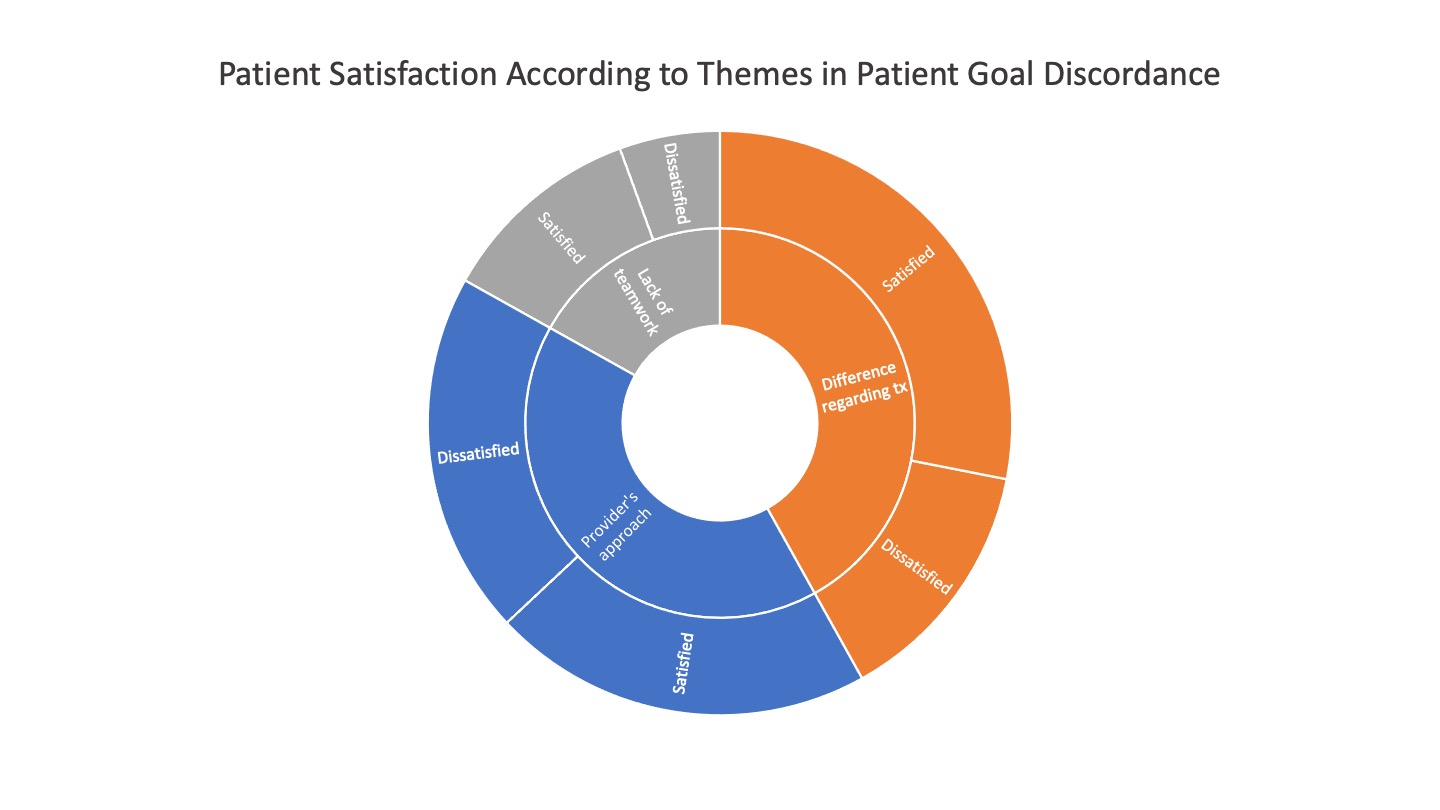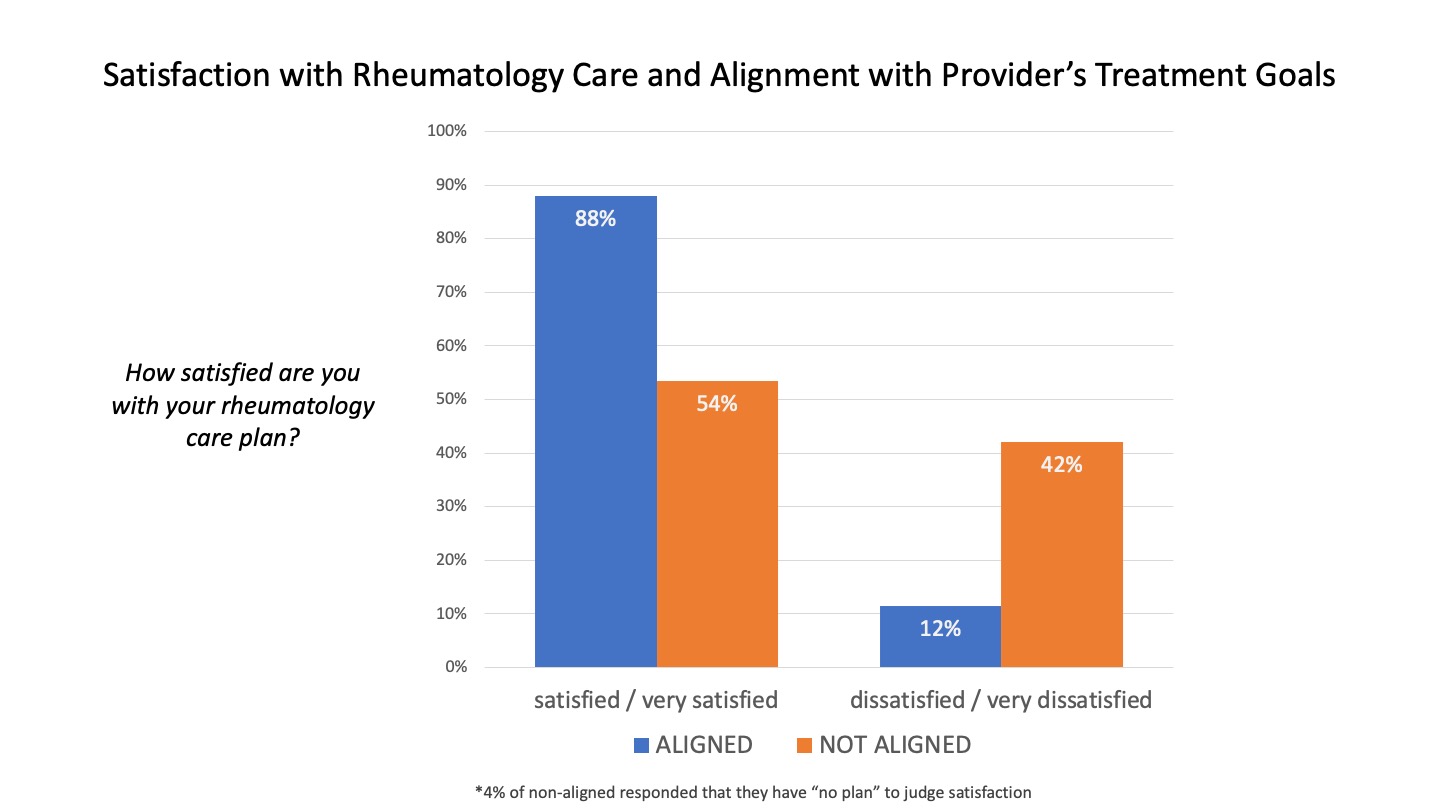Back
Poster Session C
Epidemiology, health policy and outcomes
Session: (1332–1359) Patient Outcomes, Preferences, and Attitudes Poster II
1343: Satisfaction with Rheumatoid Arthritis Care Is Related to Discordance with Providers’ Treatment Goals and Patients’ Reasons for Disagreement
Sunday, November 13, 2022
1:00 PM – 3:00 PM Eastern Time
Location: Virtual Poster Hall
- KO
Kelly O'Neill, BA
Rheumatoid Patient Foundation, Inc.
Winter Springs, FL, United States
Abstract Poster Presenter(s)
Kelly O'Neill1, Pamela Sinicrope2, Cynthia Crowson3, Kathryne Marks4, Rachel Giblon5, Elena Myasoedova2 and John Davis2, 1Rheumatoid Patient Foundation, Winter Springs, FL, 2Mayo Clinic, Rochester, MN, 3Mayo Clinic, Eyota, MN, 4Brigham and Women's Hospital, Boston, MA, 5Mayo Clinic, Rochester, MN, Rochester, MN
Background/Purpose: We previously reported on the incidence of shared treatment goal discussions which are associated with disease activity (DA) improvement and satisfaction within rheumatology care. Building on our previous reports, we aimed to gain insight into the nature of discordance in rheumatoid arthritis (RA) treatment goals and explore its relationship to patient satisfaction with care.
Methods: An anonymous online questionnaire was presented in 2019 on a secure survey system. U.S. residents ≥18 years of age with a self-reported RA diagnosis by a medical professional responded to questions on demographics, DA, diagnosis and DMARD history, and RA treatment goals. Participants were asked how their providers' RA treatment goals differed from their own. Responses were assessed and coded thematically using qualitative content analysis to identify reasons their goals differed from their providers'. Responses were also coded for strong emotion, poor communication, and difference in outcome expectation (high or low). Relationships between patient demographics and discordance in treatment goals and patient satisfaction were assessed using Chi-square tests for categorical variables and Kruskal-Wallis tests for continuous variables.
Results: The questionnaire was completed by 907 RA patients (90% women), with 58 (11) years mean (SD) age and 11 (10) years since diagnosis. 82% (n=740) responded to the question "How do you think your healthcare provider's treatment goals differ from your own goals?". Of those, 53% (n=392) did not differ ("aligned" with their providers' goals); 47% (n=348) reported one or more reasons they differed with respect to treatment goals ("non-aligned"). Patient satisfaction was highest in those aligned with their providers' goals (88%), compared to those non-aligned (54%, p< .0001). Among those non-aligned, major themes were providers' approach (PA, 48%), differences regarding treatment (DT, 49%) and lack of teamwork (LT, 20%). Dissatisfaction was highest within the PA theme, with 49% dissatisfaction compared to only 36% in the non-PA group (p=0.002).
Conclusion: This survey found previously unreported associations between patient satisfaction with RA treatment and discordance with provider's treatment goals. Our study is unique in that patients are asked about discordance with provider's goals and their satisfaction with care. Further research should seek greater insight to patient concerns in RA treatment goals and investigate their significance in RA treatment satisfaction.
.jpg) Themes in patients' discordance with providers' goals are arranged by levels of patient satisfaction with rheumatology care.
Themes in patients' discordance with providers' goals are arranged by levels of patient satisfaction with rheumatology care.
 The three major themes of patient goal discordance, lack of teamwork, provider’s approach, and difference regarding treatment, are divided by patient satisfaction with their rheumatology treatment. Those stating their discordance as provider’s approach had the highest level of dissatisfaction.
The three major themes of patient goal discordance, lack of teamwork, provider’s approach, and difference regarding treatment, are divided by patient satisfaction with their rheumatology treatment. Those stating their discordance as provider’s approach had the highest level of dissatisfaction.
 Respondents are categorized by alignment with their provider’s goals and by satisfaction with rheumatology care. Those who considered their goals aligned with their provider’s were more satisfied with their rheumatology care.
Respondents are categorized by alignment with their provider’s goals and by satisfaction with rheumatology care. Those who considered their goals aligned with their provider’s were more satisfied with their rheumatology care.
Disclosures: K. O'Neill, None; P. Sinicrope, None; C. Crowson, None; K. Marks, None; R. Giblon, None; E. Myasoedova, None; J. Davis, Pfizer.
Background/Purpose: We previously reported on the incidence of shared treatment goal discussions which are associated with disease activity (DA) improvement and satisfaction within rheumatology care. Building on our previous reports, we aimed to gain insight into the nature of discordance in rheumatoid arthritis (RA) treatment goals and explore its relationship to patient satisfaction with care.
Methods: An anonymous online questionnaire was presented in 2019 on a secure survey system. U.S. residents ≥18 years of age with a self-reported RA diagnosis by a medical professional responded to questions on demographics, DA, diagnosis and DMARD history, and RA treatment goals. Participants were asked how their providers' RA treatment goals differed from their own. Responses were assessed and coded thematically using qualitative content analysis to identify reasons their goals differed from their providers'. Responses were also coded for strong emotion, poor communication, and difference in outcome expectation (high or low). Relationships between patient demographics and discordance in treatment goals and patient satisfaction were assessed using Chi-square tests for categorical variables and Kruskal-Wallis tests for continuous variables.
Results: The questionnaire was completed by 907 RA patients (90% women), with 58 (11) years mean (SD) age and 11 (10) years since diagnosis. 82% (n=740) responded to the question "How do you think your healthcare provider's treatment goals differ from your own goals?". Of those, 53% (n=392) did not differ ("aligned" with their providers' goals); 47% (n=348) reported one or more reasons they differed with respect to treatment goals ("non-aligned"). Patient satisfaction was highest in those aligned with their providers' goals (88%), compared to those non-aligned (54%, p< .0001). Among those non-aligned, major themes were providers' approach (PA, 48%), differences regarding treatment (DT, 49%) and lack of teamwork (LT, 20%). Dissatisfaction was highest within the PA theme, with 49% dissatisfaction compared to only 36% in the non-PA group (p=0.002).
Conclusion: This survey found previously unreported associations between patient satisfaction with RA treatment and discordance with provider's treatment goals. Our study is unique in that patients are asked about discordance with provider's goals and their satisfaction with care. Further research should seek greater insight to patient concerns in RA treatment goals and investigate their significance in RA treatment satisfaction.
.jpg) Themes in patients' discordance with providers' goals are arranged by levels of patient satisfaction with rheumatology care.
Themes in patients' discordance with providers' goals are arranged by levels of patient satisfaction with rheumatology care. The three major themes of patient goal discordance, lack of teamwork, provider’s approach, and difference regarding treatment, are divided by patient satisfaction with their rheumatology treatment. Those stating their discordance as provider’s approach had the highest level of dissatisfaction.
The three major themes of patient goal discordance, lack of teamwork, provider’s approach, and difference regarding treatment, are divided by patient satisfaction with their rheumatology treatment. Those stating their discordance as provider’s approach had the highest level of dissatisfaction. Respondents are categorized by alignment with their provider’s goals and by satisfaction with rheumatology care. Those who considered their goals aligned with their provider’s were more satisfied with their rheumatology care.
Respondents are categorized by alignment with their provider’s goals and by satisfaction with rheumatology care. Those who considered their goals aligned with their provider’s were more satisfied with their rheumatology care.Disclosures: K. O'Neill, None; P. Sinicrope, None; C. Crowson, None; K. Marks, None; R. Giblon, None; E. Myasoedova, None; J. Davis, Pfizer.

